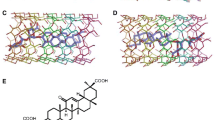Abstract
In crystalline β-cyclodextrin undecahydrate (β-cyclodextrin · 11 H2O), flip-flop hydrogen bonds O-H⋯O-H⇋H-O⋯H-O have been detected by neutron diffraction studies. In this type of bond the directionality is inverted dynamically even in the crystalline state as could be shown by diffraction experiments carried out at 293 K and at 120 K. Molecular dynamics methods (MD) can be used to simulate the dynamics of molecular systems on a computer. In this paper, the atomic trajectories obtained by MD simulations, of β-cyclodextrin at 293 K and at 120 K and of α-cyclodextrin at 293 K, are analysed with respect to the occurrence of hydrogen bonds of flip-flop type. In all three simulations the hydrogen bonds with the highest percentage of occurrence correspond to the ones found in the neutron diffraction structure. In the simulation of crystalline β-cyclodextrin at 293 K over 19 ps, sixteen out of eighteen experimentally detected flip-flop bonds are reproduced. The other two hydrogen bonds are unidirectional, O-H⋯O, i.e. they have a lifetime larger than 19 ps. The four experimentally observed flip-flops at 120 K are not seen in a 20 ps MD simulation. For α-cyclodextrin a flip-flop hydrogen bond is predicted with low population, which may be observed experimentally. The good agreement between MD calculations and neutron diffraction studies suggests that the force field used in the simulations yields a good description of cyclodextrin crystal structure at room temperature, and even the energetically delicate dynamic hydrogen bond flip-flop phenomenon is satisfactorily reproduced.
Similar content being viewed by others
References
Betzel C, Saenger W, Hingerty BE, Brown GM (1984) Circular and flip-flop hydrogen bonding in β-cyclodextrin undecahydrate: a neutron diffraction study. J Am Chem Soc 106: 7545–7557
Chacko KK, Saenger W (1981) Topography of cyclodextrin inclusion complexes. 15. Crystal and molecular structure of the cyclohexamylose. 7.57 water complex, form (III). Four- and six-membered circular hydrogen bonds. J Am Chem Soc 103:1708–1715
D'Souza VT, Bender ML (1987) Miniature organic models of enzymes. Acc Chem Res 20:146–152
Etten RL van, Sebastian JF, Clowes GA, Bender ML (1967) Acceleration of phenyl-ester cleavage by cycloamyloses. A model for enzymatic specifity. J Am Chem Soc 89: 3242–3262
Fujiwara T, Yamazaki M, Tomiza Y, Tokuoka R, Tomita KI, Matsuo T, Suga H, Saenger W (1983) The crystal structure of a new form of β-cyclodextrin water inclusion compound and thermal properties of β-cylcodextrin inclusion complexes. Nippon Kagaku Kaishi 2:181–187
Klar B, Hingerty BE, Saenger W (1980) Topography of cyclodextrin inclusion complexes. XII. Hydrogen bonding in the crystal structure of α-cyclodextrin hexahydrate: the use of a multicounter detector in neutron diffraction. Acta Crystallogr B36:1154–1165
Koehler JEH, Saenger W, Gunsteren WF van (1987a) A molecular dynamics simulation of crystalline α-cyclodextrin hexahydrate. Eur Biophys J 15:197–210
Koehler JEH, Saenger W, Gunsteren WF van (1987b) Molecular dynamics simulation of crystalline β-cyclodextrin dodecahydrate at 293 K and 120 K. Eur Biophys J 15:211–224
Koehler JEH, Saenger W, Lesyng B (1987) Cooperative effects in extended hydrogen bonded systems involving O-H groups. Ab initio studies of the cyclic S4 water tetramer. J Comp Chem 8:1090–1098
Lesyng B, Saenger W (1981) Theoretical investigations on circular and chain-like hydrogen bonded structures found in two crystal forms of α-cyclodextrin hexahydrate. Biochim Biophys Acta 678:408–413
Lindner K, Saenger W (1980) Crystal structure of the γ-cyclodextrin. Propanol inclusion complex; Correlation of α-, β-, γ-cyclodextrin geometries. Biochem Biophys Res Commun 92:933–938
Lindner K, Saenger W (1982) Topography of cyclodextrin inclusion complexes. XVI. Cyclic system of hydrogen bonds: Structure of α-cyclodextrin hexahydrate form (II): Comparison with form (I). Acta Crystallogr B38:203–210
Saenger W (1979) Circular hydrogen bonds. Nature 279: 343–344
Saenger W (1980) Cyclodextrins in research and industry. Angew Chem Int Ed Engl 19:344–362
Saenger W (1984) Structural aspects of cyclodextrins and their inclusion complexes. In: Atwood JL, Davies JED, MacNicol (eds) Inclusion compounds, vol II. Academic Press, New York, pp 231–259
Saenger W, Betzel C, Hingerty BE, Brown GM (1982) Flip-flop hydrogen bonding in a partially disordered system. Nature 296:581–583
Szejtli J (1982) Cyclodextrins and their inclusion complexes. Akademiai Kiado, Budapest
Zabel V, Saenger W, Mason SA (1986) A neutron diffraction study of the hydrogen bonding in β-cyclodextrin undecahydrate at 120 K: from dynamic flip-flops to static homodromic chains. J Am Chem Soc 108:3664–3673
Author information
Authors and Affiliations
Rights and permissions
About this article
Cite this article
Koehler, J.E.H., Saenger, W. & van Gunsteren, W.F. The flip-flop hydrogen bonding phenomenon. Eur Biophys J 16, 153–168 (1988). https://doi.org/10.1007/BF00261901
Received:
Accepted:
Issue Date:
DOI: https://doi.org/10.1007/BF00261901




